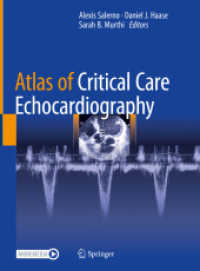- ホーム
- > 洋書
- > 英文書
- > Computer / General
Full Description
This book presents the key technology of electronic noses, and systematically describes how e-noses can be used to automatically analyse odours. Appealing to readers from the fields of artificial intelligence, computer science, electrical engineering, electronics, and instrumentation science, it addresses three main areas: First, readers will learn how to apply machine learning, pattern recognition and signal processing algorithms to real perception tasks. Second, they will be shown how to make their algorithms match their systems once the algorithms don't work because of the limitation of hardware resources. Third, readers will learn how to make schemes and solutions when the acquired data from their systems is not stable due to the fundamental issues affecting perceptron devices (e.g. sensors).
In brief, the book presents and discusses the key technologies and new algorithmic challenges in electronic noses and artificial olfaction. The goal is to promote the industrial application of electronic nose technology in environmental detection, medical diagnosis, food quality control, explosive detection, etc. and to highlight the scientific advances in artificial olfaction and artificial intelligence.
The book offers a good reference guide for newcomers to the topic of electronic noses, because it refers to the basic principles and algorithms. At the same time, it clearly presents the key challenges - such as long-term drift, signal uniqueness, and disturbance - and effective and efficient solutions, making it equally valuable for researchers engaged in the science and engineering of sensors, instruments, chemometrics, etc.
Contents
Part 1 : Overview.- Chapter 1. Introduction.- Chapter 2. Literature Review.- Part 2 : E-nose Odor Recognition and Prediction: Challenge I.- Chapter 3. Heuristic and Bio-inspired Neural Network Model.- Chpater 4. Chaos based Neural Network Optimization Approach.- Chapter 5. Multilayer Perceptrons based Concentration Estimation, etc.







